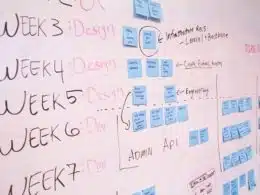Ever come across the term “process interleaving” or “interleaved processes” in the context of software engineering?
This article aims to explore this topic along with the advantages of invariably interleaving the software design and implementation processes in software development or engineering.
Without further ado, let’s get right into it!
What is Process Interleaving in Software Engineering?
In software engineering, the term “process interleaving” is a methodology or manner in which processes are arranged or conducted in a non-contiguous manner or often in a tandem or parallel way which allows alternating between the 2 processes. It’s considered a redundant process where activities of the software development life cycle (SDLC) are interleaved in an effort to make a system more efficient and for optimal error correction.
Therefore, it forms the basis of the incremental development model. To read more on what is incremental development, you can check out our other post here.
Why the Software Design and Implementations Processes are Invariably Interleaved Activities?
In this case, the intention is similar, where the software design and implementation processes are invariably or always interleaved. Thus, these steps go hand in hand where the developers will be alternating between these 2 steps to ensure the final system is designed and implemented in a way that fulfils the predetermined requirements.
What Happens in the Design Stage?
By viewing these processes separately, firstly, in software engineering, designing is a creative stage where we model the overall system, its components and their relationships while following closely to the user’s specified requirements. This can be demonstrated through a class diagram that details the classes involved which represent the software components as well as the relationships among them whether it’s a basic association, composition, aggregation or inheritance.
Along with that, we can use this class diagram to model the system’s database as well, to identify the data that needs to be stored, the variables and which data types to use. Overall, at this design stage, we’re conceptualising the system as a solution to the users’ requirements and creating a detailed architecture and layout of the system.
The degree of detail of this design is based on the type of system being developed and the development method employed, whether plan-driven or agile. So, this serves as a blueprint, outlining the workflow and structure we can follow during the implementation stage. Plus, we can isolate and remove any errors from the design before moving developing the system.
What Happens in the Implementation Stage?
Secondly, the implementation stage is where the project takes shape, and the developer understands the flow of the design as a fully-functional program. Thus, it also involves developing or constructing the system, while closely following the design from the previous stage and the requirements collected. So, it’s normal for the developer to go back and forth between referring to the design and developing the program to ensure the program is built according to the requirements and design set and accepted by the client.
Towards the end, testing is also conducted to determine the requirements are fulfilled and the program is free from bugs. This especially holds true in an incremental development model, where the system is developed in increments, and at the end of each increment, the developer thoroughly tests the system and also delivers it to the user/client for their feedback. So, in an agile method or incremental model, the design and implementation activities are always interleaved.
Advantage 1: Allows for Efficient Error Detection and Resolution
Therefore, the main reason these 2 processes are closely linked is for efficient error detection and resolution. While the developer is creating the system design, they must keep into consideration foreseeable implementation issues as well. However, it’s difficult to forecast a potential development issue or even predict the extent or detail to which the design should be before beginning construction. Hence, there is constant backtracking and modifying to the previous design models, whenever there are implementation flaws. Progressing through the development process, more detail is added to the system.
Plus, when the developer is testing the system in the implementation stage, they may come across and identify errors within the system. So, they can return to the designing stage or drawing board to find a solution to the error before moving on with the implementation.
Advantage 2: Gives the Clients a Chance to Review the System and Provide Feedback
At the same time, during testing, often the system is delivered to clients for their feedback as well. So, this feedback can be incorporated into the design before the complete implementation. Doing this provides the clients with another opportunity to elicit requirements or functionality to be incorporated into the system.
All in all, this improves workflow efficiency and ensures that the final system is both correctly designed and implemented according to the design and requirements.
Conclusion
Nevertheless, there are still certain types of systems, where interleaving the design and implementation stage is more challenging. This is in systems where safety is the utmost priority, where a detailed design should be readied before any implementation can be started.
On that note, overall, interleaving essential processes, mainly the design and implementation stages, can have tremendous advantages in a particular software development lifecycle or the production of the final system. These benefits include making troubleshooting and resolving errors more efficient as well as providing the stakeholders with an opportunity to test and review the system for requirements elicitation.
That being said, we hope that this guide has shed some more light on what is process interleaving from a software engineering standpoint and the advantages it can bring about.
Feel free to comment down below, if you have any questions regarding the matter or any extra experience or information about process interleaving. We’ll love to hear them!
Do share this post with your fellow software engineering enthusiasts and whoever you know that needs more information on process interleaving.

















